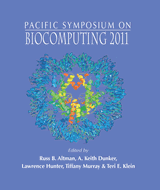Workshop on the Validation and Modeling of Electron Cryo-Microscopy Structures of Biological Nanomachines
Steven Ludetke1, Catherine Lawson2, Gerard Kleywegt3, Helen Berman2, Wah Chiu1
1Verna & Marrs McLean Dept. of Biochem. & Mol. Biology, Baylor College of Medicine, 1 Baylor Plaza , Houston, TX 77030, USA; 2Rutgers, The State University of New Jersey, Department of Chemistry & Chemical Biology and Research Collaboratory for Structural Bioinformatics, 610 Taylor Road Piscataway, NJ 08854, USA; 3Protein Data Bank in Europe, EMBL-EBI, Wellcome Trust Genome Campus, Hinxton, Cambridge CB10 1SD, UK;
Email: sludtke@bcm.edu
Pacific Symposium on Biocomputing 16:369(2011)

Abstract
Electron cryo-microscopy (cryoEM) is a rapidly maturing methodology in structural biology, which now enables the determination of 3D structures of molecules, macromolecular complexes and cellular components at resolutions as high as 3.5Å, bridging the gap between light microscopy and X-ray crystallography/NMR. In recent years structures of many complex molecular machines have been visualized using this method. Single particle reconstruction, the most widely used technique in cryoEM, has recently demonstrated the capability of producing structures at resolutions approaching those of X-ray crystallography, with over a dozen structures at better than 5 Å resolution published to date . This method represents a significant new source of experimental data for molecular modeling and simulation studies. CryoEM derived maps and models are archived through EMDataBank.org joint deposition services to the EM Data Bank (EMDB) and Protein Data Bank (PDB), respectively. CryoEM maps are now being routinely produced over the 3 - 30 Å resolution range, and a number of computational groups are developing software for building coordinate models based on this data and developing validation techniques to better assess map and model accuracy. In this workshop we will present the results of the first cryoEM modeling challenge, in which computational groups were asked to apply their tools to a selected set of published cryoEM structures. We will also compare the results of the various applied methods, and discuss the current state of the art and how we can most productively move forward.
[Full-Text PDF] [PSB Home Page]